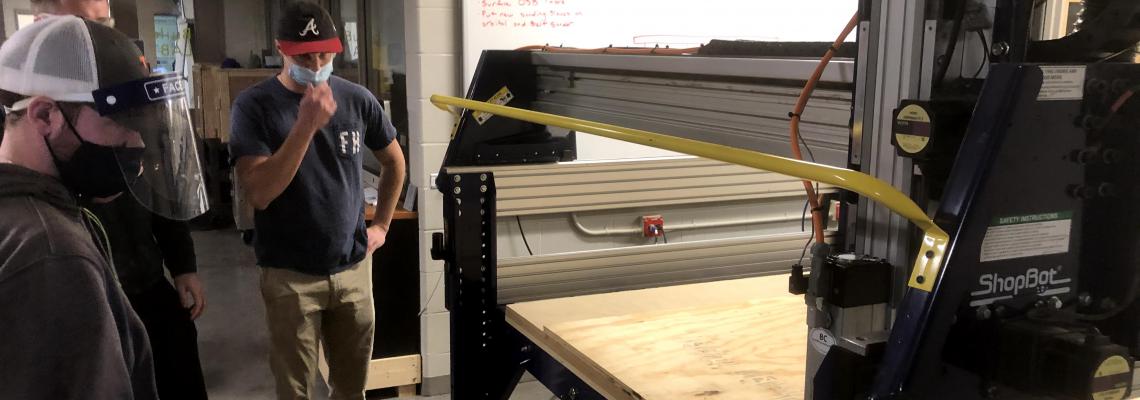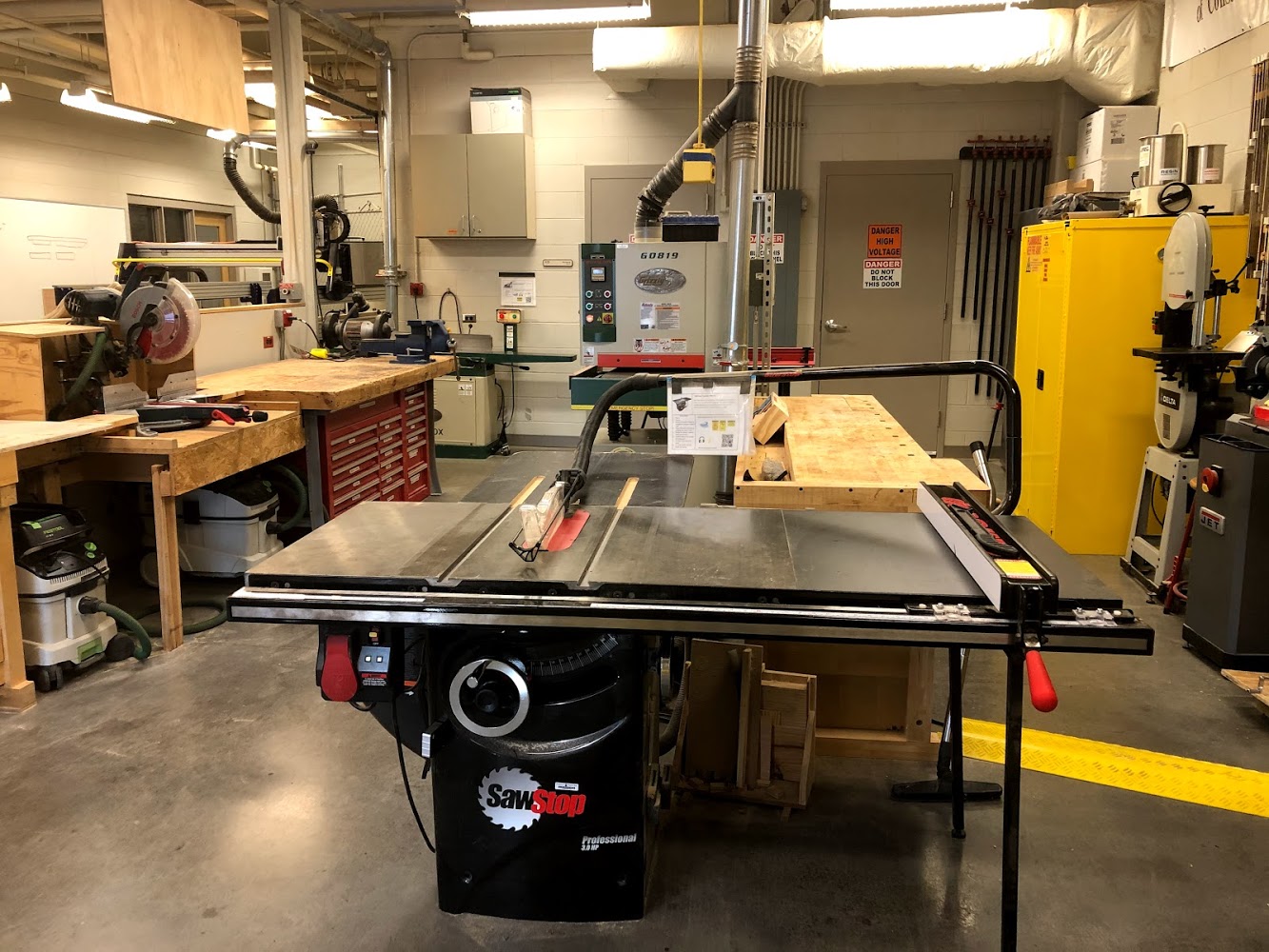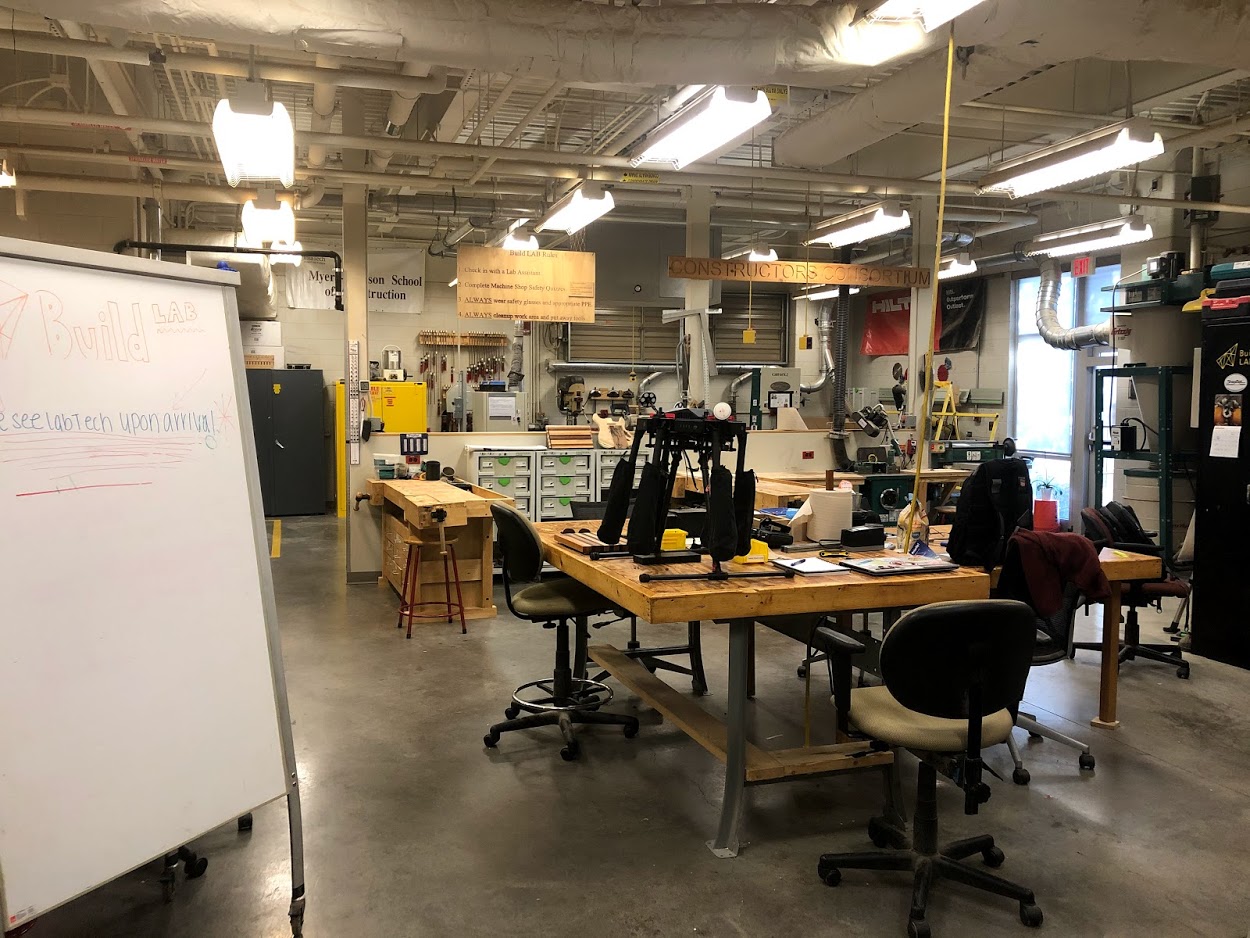The BuildLAB is a venture launched by The Department of Building Construction and the Myers-Lawson School of Construction at Virginia Tech. Established in 2013, the lab's goal is to serve Virginia Tech's "Hands-on Minds-on" philosophy of applied learning by fostering a supportive environment for innovation of all kinds.
The BuildLAB's emphasis is placed on a goal of discovery rather than the direct purpose, based on the notion that the most interesting and impactful discoveries come from trial and error, attempts of new things, curiosity, and serendipity. The lab features a more or less complete range of equipment and tools with a material focus on wood and composites to support this approach. Also, the lab features a substantial component of computer-controlled machines in the vein of the 'Fab-Lab' concept. Our goal is to make anything out of anything from small to large and from personal to universal.
The student-led team running the day-to-day needs in the space has set lofty goals and had allowed their best instincts to drive the approach to manage the BuildLAB. The use of the lab ultimately dictates the facility's development and adaptation to suit our Virginia Tech community's broader goals. To that end, the lab crew likes to invite users, visitors (who will hopefully become users), and other interested parties to visit and contribute.
Training
All users are required to have proper training through the Environmental Health and Safety website.
Required Training:
- Lockout-Tagout Awareness
- HAZCOM RTK
- Machine Shop Safety
- Hand and Power Tool Safety - located under Machine Shop
- Personal Protective Equipment (PPE)
- Portable Fire Extinguishers - Must retake every 2 years
Once you have taken these required training sessions, come check in with a lab tech, and they will sign you in.
Machine Status
- CNC with a cutting area is 5 ft by 10 ft with a z of 16 inches (working as of 9/29/2022)
- laser with a work area of 1 foot by 2 feet (working as of 9/29/2022)
- laser with a work area of 2.5 feet by 3.5 feet (working as of 9/291/2022)
- Ender Pro 3 v2 direct drive which has a bed of 220mm by 220mm (working as of 9/29/2022)
- Ender Pro 3 v2 which has a bed of 220mm by 220mm (working as of 9/29/2022)
- Lulzbot has a bed of 250mm by 250mm (working as of 9/29/2022)
Assume all woodworking tools are operational unless stated otherwise.
BuildLAB Rules
- Check-in with a Lab Assistant
- Complete Safety Quizzes
- ALWAYS wear safety glasses and appropriate PPE
- ALWAYS clean up the work area and put away tools
- If you do break any of the rules we do reserve the right to deny access to the lab since safety is our main priority.
CNC Policy
The computer numerical control (CNC) system uses Fusion and Aspire software to convert 3D models and cut them out with a router bit. Wood, plastics, foam, cork, and other materials can be used on this machine. Topographic maps, models, and parts of a design are examples of types of projects made on the CNC.
General Use:
- All cuts will be scheduled and overlooked by a lab tech.
- The CNC cannot be used for more than 12 hours per week by a group for a school-related project. Total of 18 setup and cutting hours per 2 weeks. The CNC is only available 8 hours a week for someone doing a personal project.
- Every project must be sent to the staff as a Fusion 360 file (.f3d), step (.stp), or solid works (.sldprt). We cannot currently use rhino, grasshopper, nor mesh files since we cannot easily fix any problems. If you have a drawing (.dxf) we will only do one sheet or 20 objects worth of CAD work this can easily be done in fusion, rhino, inventer, solidworks and many more.
- The build lab staff currently uses fusion 360 to set up the cam so please give them 2 business days to set up the cam if you don’t know how to do it and 1 business day if you can set it up. If your file has messed up lines or a corrupt part we will ask you to fix it as it is not our responsibility. If you do need help please come in with your laptop and we will try and help.
- All materials are to be provided by the user. The build lab does have a large assortment of bits open to everyone but if you would like to buy your own we have SAE collets from 1/16 inch shaft to 5/8 inch shaft. We also have metric collects but do not use them.
Terms:
- If a class is taught and the CNC is too loud, we have the right to stop the cut.
- If the project is out of control, we have the right to cancel the cut.
- Clean up, and removal of all materials is the responsibility of the user.
Banned Materials for CNC:
- MDF using a 1/2 bit or larger for sheet goods
- MDF for topogrophies
- Warped sheet goods
- Aluminum that does not have a hold down jig
Important notes:
- The CNC currently cannot cut aluminum since we do not have to proper hold-downs and tooling.
- The smallest project for cutouts is 8 inches by 6 inches
- If you plan on cutting out plywood, the material must have less than a 1-inch deflection or bend over 96 inches so the vacuum table can pull it down.
- The CNC cutting area is 5 ft by 10 ft with a z of 16 inches but can change depending on the bit height.
Laser Policy
General Use:
- Check-in with a Lab Assistant to receive the power cord or key.
- If it is your first time using the laser, a Lab Assistant will assist you with your project.
- The sizes of the two laser beds are 24" x 36" and 36" x 48" respectively.
Instructions:
Vector cutting with Inkscape:
- Select the lines to be cut.
- Edit the lines to .001 RGB in and red
- Print the file as a PDF
- Then open the PDF reader that you printed to and print to the UCP driver
Vector Cutting with AutoCAD:
- Select the lines to be cut.
- Edit the lines to .001 in and red.
- Export the file as a PDF
- Make sure the letter size is edited to your dimensions.
Laser
- Print PDF to "PLS3.6" laser
- Edited the file to the correct position.
- Select the red vector cut to full power
- If there is no engraving, then set the black cut to zero
- Set the speed to 2% on the red vector cut.
- Then press play.
3D printers
- Please have your file as an STL file type.
- If you need to make changes to your file please provide it as a Fusion 360 file (.f3d) or solid works (.sldprt).
- If you are not In the Building construction department and need more than 50 grams of filament you will need to provide your own.
- We will run a print up to 3 times but if it keeps failing we will ask that you change your file or ask a more experienced lab to try.
- The two smaller 3d printers are Ender Pro 3 which have a bed of 220mm by 220mm while the lulzbot has a bed of 250mm by 250mm.





